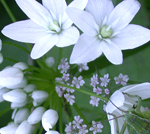Using alliums in borders
Matthew Wilson looks at the best ways to use the diverse range of alliums in for summer colour


It's easy to appreciate why the large-flowered border allium has become such a popular plant. Cultivars such as Globemaster, Purple Sensation and Firmament are plants of great beauty, and almost without vice. They also enjoy longevity well beyond their start-of-summer flowering period, due to their architectural seed heads, which bleach to a straw-white as the summer progresses, keeping their stature until autumn in the border, unless cut for indoor dry arrangements.
At Harlow Carr, in Yorkshire, we’ve planted more than 6,000 allium bulbs to illuminate the Main Borders in May and June; they’re an arresting sight. The larger varieties, such as white-flowered Mont Blanc, borne on robust stems more than 3ft tall, help to create a sense of rhythmic unity to a border when planted en masse.
For more garden features like this every week, subscribe and save As impressive as these big-flowered border varieties are, there are Allium species with simpler charms; less conspicuous they might be, but they deserve a place in the garden. Allium neapolitanum is modest in size a little more than 1ft tall but has pretty sprays of small, white, starry flowers held on wiry stems, perfect for growing in most soils in partial shade or full sun. It’s a native of southern Europe and parts of Asia, although it’s also naturalised itself as far north as Guernsey, that hotbed of feral garden plants, where it’s known as the Guernsey-Star-of-Bethlehem.
Another native of southern Europe, but altogether more chunky and brash, is Allium moly. Still demure in stature at under 1ft tall, it looks impressive illuminating dappled shade beneath trees, where it will spread gently but not invasively. Given too rich a soil, A. moly, and many of the species Allium, have the potential to run wild.
The nodding onion, A. cernuum, is better suited to a sunny spot and is a rather handsome, low-growing plant with a head of gracefully drooping deep pink flowers. It will seed around a bit, forming a decent-sized colony, and is best used as a plant to drift through others I planted it at Hyde Hall with Genista lydia, Iris Langport Wren and Geranium x magnificum, where their combined efforts prevented the little onion from taking over, allowing it to pop up through their foliage where there were gaps that needed filling.
A. caeruleum, on the other hand, I have never been able to hang on to, which is a shame, as the blue onion is unique among the ornamental onions in having ping-pong-ball-sized heads of bright blue flowers, held aloft at 18in or so, on thin stems. I plant it properly in full sun with a little grit under the bulb to help drain-age, but within two or three seasons, it disappears. Perhaps that’s all it ever manages?
For more garden features like this every week, subscribe and save Not all of the wild species of Allium are compact. I’ve recently started planting larger species, such as A. atropurpureum, instead of the big cultivars. This native of the Balkans grows 2ft–3ft tall and is topped with wonderfully dark, burgundy-red flower heads.
Sign up for the Country Life Newsletter
Exquisite houses, the beauty of Nature, and how to get the most from your life, straight to your inbox.
Visitors to Harlow Carr garden seem to love the depth of colour. Beside it are creamy white-flowered A. nigrum and A. schubertii, the most extraordinary confection that looks more like a firework, mid-explosion, than a wild plant, the dried flowerheads sometimes rolling across the garden like ornamental tumbleweed.
Country Life is unlike any other magazine: the only glossy weekly on the newsstand and the only magazine that has been guest-edited by HRH The King not once, but twice. It is a celebration of modern rural life and all its diverse joys and pleasures — that was first published in Queen Victoria's Diamond Jubilee year. Our eclectic mixture of witty and informative content — from the most up-to-date property news and commentary and a coveted glimpse inside some of the UK's best houses and gardens, to gardening, the arts and interior design, written by experts in their field — still cannot be found in print or online, anywhere else.
-
 'Monolithic, multi-layered and quite, quite magnificent. This was love at first bite': Tom Parker Bowles on his lifelong love affair with lasagne
'Monolithic, multi-layered and quite, quite magnificent. This was love at first bite': Tom Parker Bowles on his lifelong love affair with lasagneAn upwardly mobile spaghetti Bolognese, lasagne al forno, with oozing béchamel and layered meaty magnificence, is a bona fide comfort classic, declares Tom Parker Bowles.
By Tom Parker Bowles
-
 Country houses, cream teas and Baywatch: Country Life Quiz of the Day, April 24, 2025
Country houses, cream teas and Baywatch: Country Life Quiz of the Day, April 24, 2025Thursday's Quiz of the Day asks exactly how popular Baywatch became.
By Toby Keel